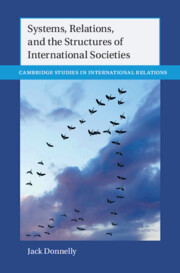Book contents
- Systems, Relations, and the Structures of International Societies
- Cambridge Studies in International Relations
- Systems, Relations, and the Structures of International Societies
- Copyright page
- Contents
- Figures
- Tables
- Acknowledgments
- Part I Systems, Relations, Levels, and Explanations
- Part II Waltzian Structural Theory
- Part III Systems, Relations, and Processes
- Part III (A) Differentiation and Continuous (Trans)Formation
- Part III (B) Four Excursions in Relational/Systemic IR
- 14 Normative-Institutional Differentiation
- 15 Vertical Differentiation
- 16 Levels, Centers, and Peripheries
- 17 Continuous (Trans)formation of Eurocentric Political Systems (c. 1225 – c. 2025)
- 18 Afterword
- References
- Index
- Cambridge Studies in International Relations
17 - Continuous (Trans)formation of Eurocentric Political Systems (c. 1225 – c. 2025)
from Part III (B) - Four Excursions in Relational/Systemic IR
Published online by Cambridge University Press: 19 October 2023
- Systems, Relations, and the Structures of International Societies
- Cambridge Studies in International Relations
- Systems, Relations, and the Structures of International Societies
- Copyright page
- Contents
- Figures
- Tables
- Acknowledgments
- Part I Systems, Relations, Levels, and Explanations
- Part II Waltzian Structural Theory
- Part III Systems, Relations, and Processes
- Part III (A) Differentiation and Continuous (Trans)Formation
- Part III (B) Four Excursions in Relational/Systemic IR
- 14 Normative-Institutional Differentiation
- 15 Vertical Differentiation
- 16 Levels, Centers, and Peripheries
- 17 Continuous (Trans)formation of Eurocentric Political Systems (c. 1225 – c. 2025)
- 18 Afterword
- References
- Index
- Cambridge Studies in International Relations
Summary
This chapter, which is by far the longest in the book, looks at the Eurocentric political world over the past eight centuries employing the spatio-political typology sketched in the preceding chapter and the frame of continuous (trans)formation presented in . I argue that on time frames of multiple centuries, dramatic change often is evident. But on time frames of several decades, continuity usually is much more evident. Furthermore, the processes that produce continuity and those that produce change are inextricably interrelated. For reasons of space, I focus especially on the early modern period, which I argue was less “modern” than a middle age between the medieval and the modern world. And rather than depict the rise (and demise) of modern states, I see a succession of different types of polities brought about through extensive and extended processes of continuous (trans)formation. The chapter concludes with a spatio-political reading of globalization that I contrast to several leading alternative framings.
Keywords
- Type
- Chapter
- Information
- Publisher: Cambridge University PressPrint publication year: 2023

